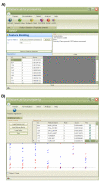PatternLab for proteomics: a tool for differential shotgun proteomics
- PMID: 18644148
- PMCID: PMC2488363
- DOI: 10.1186/1471-2105-9-316
PatternLab for proteomics: a tool for differential shotgun proteomics
Abstract
Background: A goal of proteomics is to distinguish between states of a biological system by identifying protein expression differences. Liu et al. demonstrated a method to perform semi-relative protein quantitation in shotgun proteomics data by correlating the number of tandem mass spectra obtained for each protein, or "spectral count", with its abundance in a mixture; however, two issues have remained open: how to normalize spectral counting data and how to efficiently pinpoint differences between profiles. Moreover, Chen et al. recently showed how to increase the number of identified proteins in shotgun proteomics by analyzing samples with different MS-compatible detergents while performing proteolytic digestion. The latter introduced new challenges as seen from the data analysis perspective, since replicate readings are not acquired.
Results: To address the open issues above, we present a program termed PatternLab for proteomics. This program implements existing strategies and adds two new methods to pinpoint differences in protein profiles. The first method, ACFold, addresses experiments with less than three replicates from each state or having assays acquired by different protocols as described by Chen et al. ACFold uses a combined criterion based on expression fold changes, the AC test, and the false-discovery rate, and can supply a "bird's-eye view" of differentially expressed proteins. The other method addresses experimental designs having multiple readings from each state and is referred to as nSVM (natural support vector machine) because of its roots in evolutionary computing and in statistical learning theory. Our observations suggest that nSVM's niche comprises projects that select a minimum set of proteins for classification purposes; for example, the development of an early detection kit for a given pathology. We demonstrate the effectiveness of each method on experimental data and confront them with existing strategies.
Conclusion: PatternLab offers an easy and unified access to a variety of feature selection and normalization strategies, each having its own niche. Additionally, graphing tools are available to aid in the analysis of high throughput experimental data. PatternLab is available at http://pcarvalho.com/patternlab.
Figures





Similar articles
-
Integrated analysis of shotgun proteomic data with PatternLab for proteomics 4.0.Nat Protoc. 2016 Jan;11(1):102-17. doi: 10.1038/nprot.2015.133. Epub 2015 Dec 10. Nat Protoc. 2016. PMID: 26658470 Free PMC article.
-
The APEX Quantitative Proteomics Tool: generating protein quantitation estimates from LC-MS/MS proteomics results.BMC Bioinformatics. 2008 Dec 9;9:529. doi: 10.1186/1471-2105-9-529. BMC Bioinformatics. 2008. PMID: 19068132 Free PMC article.
-
Identifying differences in protein expression levels by spectral counting and feature selection.Genet Mol Res. 2008 Apr 15;7(2):342-56. doi: 10.4238/vol7-2gmr426. Genet Mol Res. 2008. PMID: 18551400 Free PMC article.
-
Simple, efficient and thorough shotgun proteomic analysis with PatternLab V.Nat Protoc. 2022 Jul;17(7):1553-1578. doi: 10.1038/s41596-022-00690-x. Epub 2022 Apr 11. Nat Protoc. 2022. PMID: 35411045 Review.
-
Multiplexed and data-independent tandem mass spectrometry for global proteome profiling.Mass Spectrom Rev. 2014 Nov-Dec;33(6):452-70. doi: 10.1002/mas.21400. Epub 2013 Nov 26. Mass Spectrom Rev. 2014. PMID: 24281846 Review.
Cited by
-
Titanium Dioxide Nanoparticles Alter the Cellular Phosphoproteome in A549 Cells.Nanomaterials (Basel). 2020 Jan 21;10(2):185. doi: 10.3390/nano10020185. Nanomaterials (Basel). 2020. PMID: 31973118 Free PMC article.
-
Proteomic evidences for rex regulation of metabolism in toxin-producing Bacillus cereus ATCC 14579.PLoS One. 2014 Sep 12;9(9):e107354. doi: 10.1371/journal.pone.0107354. eCollection 2014. PLoS One. 2014. PMID: 25216269 Free PMC article.
-
Shotgun proteomics datasets acquired on Gammarus pulex animals sampled from the wild.Data Brief. 2019 Oct 12;27:104650. doi: 10.1016/j.dib.2019.104650. eCollection 2019 Dec. Data Brief. 2019. PMID: 31687451 Free PMC article.
-
Mechanisms of acute kidney injury induced by experimental Lonomia obliqua envenomation.Arch Toxicol. 2015 Mar;89(3):459-83. doi: 10.1007/s00204-014-1264-0. Epub 2014 May 6. Arch Toxicol. 2015. PMID: 24798088 Free PMC article.
-
Charge prediction machine: tool for inferring precursor charge states of electron transfer dissociation tandem mass spectra.Anal Chem. 2009 Mar 1;81(5):1996-2003. doi: 10.1021/ac8025288. Anal Chem. 2009. PMID: 19203245 Free PMC article.
References
-
- Florens L, Washburn MP, Raine JD, Anthony RM, Grainger M, Haynes JD, Moch JK, Muster N, Sacci JB, Tabb DL, Witney AA, Wolster D, Wu Y, Gardner MJ, Holder AA, Sinden RE, Yates JR, Carucci DJ. A proteomic view of the Plasmodium falciparum life cycle. Nature. 2002;419:520–526. doi: 10.1038/nature01107. - DOI - PubMed
Publication types
MeSH terms
Substances
Grants and funding
LinkOut - more resources
Full Text Sources

